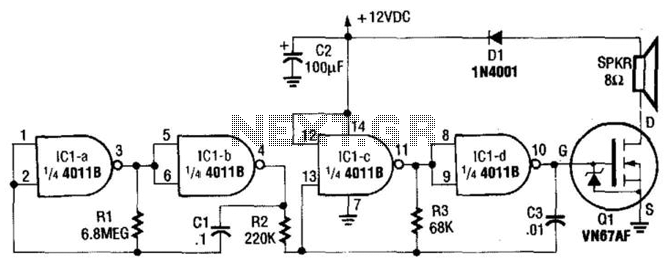
Multitone Siren

This multi-tone siren is beneficial for burglar alarms, reverse horns, and similar applications. It generates five distinct audio tones, making it significantly more attention-grabbing than a single-tone siren. The circuit is designed using the well-known CMOS oscillator and divider IC 4060, along with a small audio amplifier LM386. The IC 4060 functions as the multi-tone generator, with a 100 µH inductor connected to its input, allowing it to oscillate within an approximate range of 5 MHz RF. The IC divides RF signals into audio frequency (AF) and ultrasonic ranges. Different audio signals are accessible at pins 1, 2, 3, 13, and 15 of IC 4060 (IC1). These multi-frequency signals are combined and sent to the audio amplifier built around IC LM386. The output from IC2 is directed to a speaker via capacitor C9. For increased sound output, a power amplifier such as TBA810 or TDA1010 can be utilized. In this design, only five outputs of IC1 are employed, as the remaining outputs (pins 4 through 7 and 14) produce ultrasonic signals that are inaudible. The circuit should be assembled on a general-purpose PCB and housed in an appropriate enclosure. A regulated power supply of 6V-12V or a battery can be used to power the circuit.
The multi-tone siren circuit utilizes the CMOS IC 4060, which integrates both oscillator and frequency divider functionalities. This IC is pivotal for generating a variety of tones through its internal architecture. The 100 µH inductor connected to the input of IC 4060 is essential for establishing the oscillation frequency, which is tuned to around 5 MHz. This high-frequency oscillation is subsequently divided by the IC to generate lower frequency audio signals that are within the audible range.
The output frequencies are derived from specific pins of the IC, where each pin corresponds to a different tone. The tones produced are mixed together and amplified using the LM386 audio amplifier. The LM386 is a low-voltage audio power amplifier capable of delivering sufficient output to drive a speaker effectively. The coupling capacitor C9 serves to block any DC component from reaching the speaker, ensuring that only the AC audio signals are transmitted.
For applications requiring louder sound output, the circuit can be modified to include a more powerful amplifier, such as the TBA810 or TDA1010, which can provide higher wattage and better sound projection. This adaptability allows the siren to be tailored to specific needs, whether for home security or automotive applications.
The assembly of the circuit on a general-purpose PCB ensures that all components are securely mounted and connected, facilitating reliable operation. Enclosing the circuit in a suitable cabinet not only protects the components but also enhances the aesthetic appeal and durability of the device. The power supply can be sourced from a regulated 6V-12V supply or a battery, providing flexibility in terms of installation and usage scenarios. Overall, this multi-tone siren circuit is a versatile solution for enhancing auditory alerts in various security applications.This multi-tone siren is useful for burglar alarms, reverse horns, etc. It produces five different audio tones and is much more ear-catching than a single-tone siren. The circuit is built around popular CMOS oscillator-cum-divider IC 4060 and small audio amplifier LM386. IC 4060 is used as the mult-itone generator. A 100 µH inductor is used at the input of IC 4060. So it oscillates within the range of about 5MHz RF. IC 4060 itself divides RF signals into AF and ultrasonic ranges. Audio signals of different frequencies are available at pins 1, 2, 3, 13 and 15 of IC 4060 (IC1). These multi-frequency signals are mixed and fed to the audio amplifier built around IC LM386. The output of IC2 is fed to the speaker through capacitor C9. If you want louder sound, use power amplifier TBA810 or TDA1010. Only five outputs of IC1 are used here as the other five outputs (pins 4 through 7 and 14) produce ultrasonic signals, which are not audible. Assemble the circuit on a general-purpose PCB and enclose in a suitable cabinet. Regulated 6V-12V (or a battery) can be used to power the circuit. 🔗 External reference
The multi-tone siren circuit utilizes the CMOS IC 4060, which integrates both oscillator and frequency divider functionalities. This IC is pivotal for generating a variety of tones through its internal architecture. The 100 µH inductor connected to the input of IC 4060 is essential for establishing the oscillation frequency, which is tuned to around 5 MHz. This high-frequency oscillation is subsequently divided by the IC to generate lower frequency audio signals that are within the audible range.
The output frequencies are derived from specific pins of the IC, where each pin corresponds to a different tone. The tones produced are mixed together and amplified using the LM386 audio amplifier. The LM386 is a low-voltage audio power amplifier capable of delivering sufficient output to drive a speaker effectively. The coupling capacitor C9 serves to block any DC component from reaching the speaker, ensuring that only the AC audio signals are transmitted.
For applications requiring louder sound output, the circuit can be modified to include a more powerful amplifier, such as the TBA810 or TDA1010, which can provide higher wattage and better sound projection. This adaptability allows the siren to be tailored to specific needs, whether for home security or automotive applications.
The assembly of the circuit on a general-purpose PCB ensures that all components are securely mounted and connected, facilitating reliable operation. Enclosing the circuit in a suitable cabinet not only protects the components but also enhances the aesthetic appeal and durability of the device. The power supply can be sourced from a regulated 6V-12V supply or a battery, providing flexibility in terms of installation and usage scenarios. Overall, this multi-tone siren circuit is a versatile solution for enhancing auditory alerts in various security applications.This multi-tone siren is useful for burglar alarms, reverse horns, etc. It produces five different audio tones and is much more ear-catching than a single-tone siren. The circuit is built around popular CMOS oscillator-cum-divider IC 4060 and small audio amplifier LM386. IC 4060 is used as the mult-itone generator. A 100 µH inductor is used at the input of IC 4060. So it oscillates within the range of about 5MHz RF. IC 4060 itself divides RF signals into AF and ultrasonic ranges. Audio signals of different frequencies are available at pins 1, 2, 3, 13 and 15 of IC 4060 (IC1). These multi-frequency signals are mixed and fed to the audio amplifier built around IC LM386. The output of IC2 is fed to the speaker through capacitor C9. If you want louder sound, use power amplifier TBA810 or TDA1010. Only five outputs of IC1 are used here as the other five outputs (pins 4 through 7 and 14) produce ultrasonic signals, which are not audible. Assemble the circuit on a general-purpose PCB and enclose in a suitable cabinet. Regulated 6V-12V (or a battery) can be used to power the circuit. 🔗 External reference





